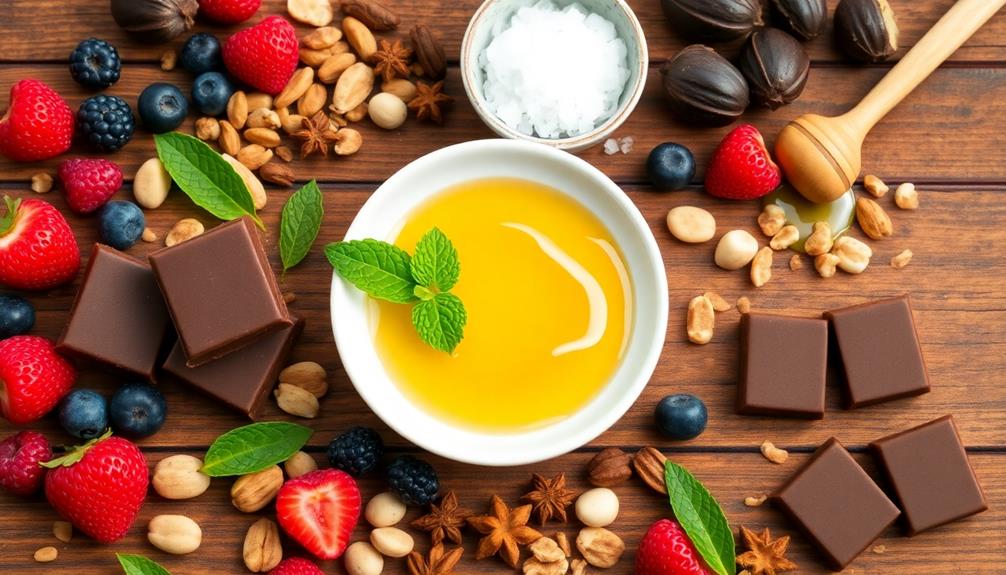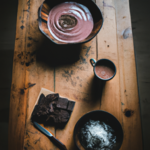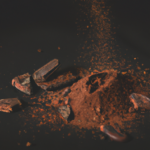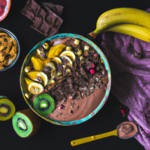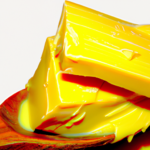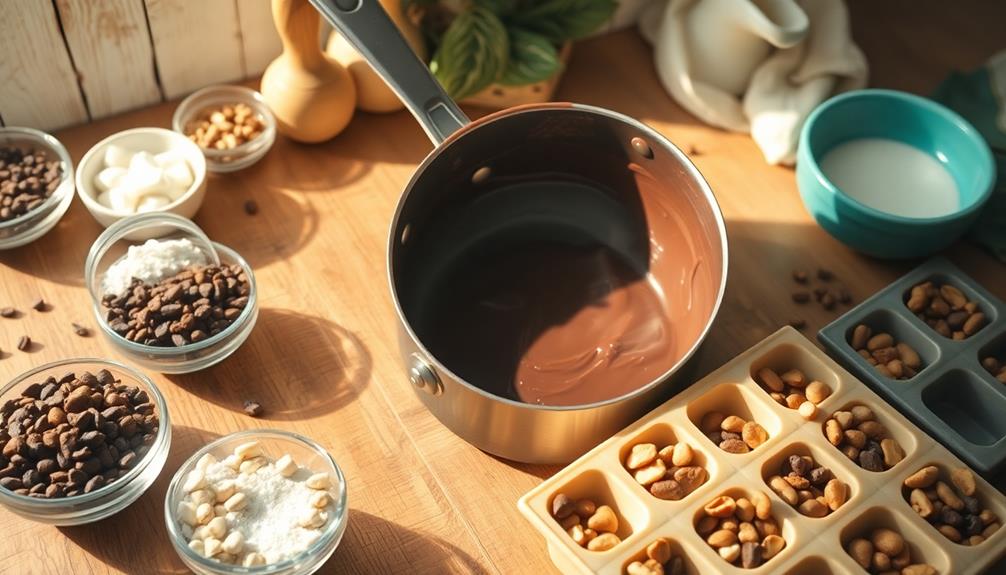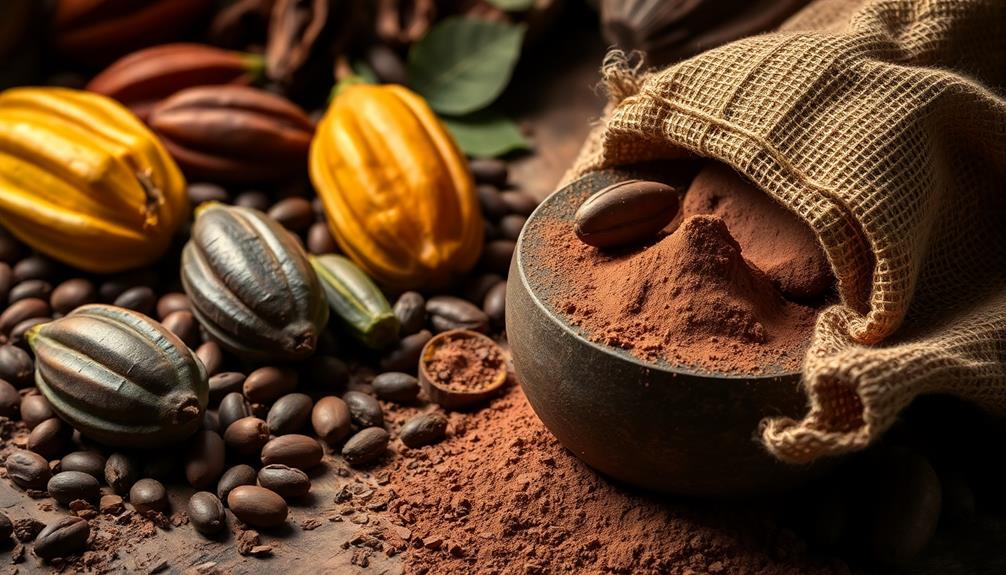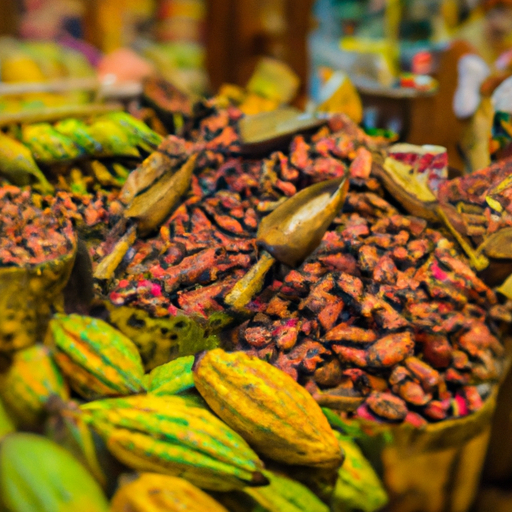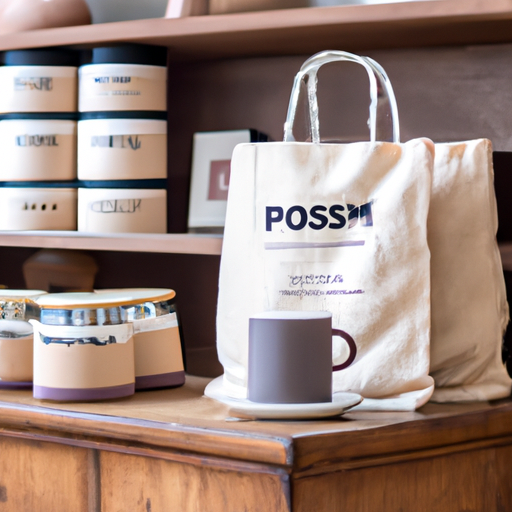Raw chocolate pairs beautifully with a variety of foods and drinks, enhancing your culinary experience. Try pairing it with fruits like raspberries and bananas to balance its rich flavors. Nuts such as almonds add crunch, while spices like cinnamon introduce warmth. Don't forget about beverages—rum or stout can elevate your chocolate enjoyment. For a fun twist, blend raw chocolate into smoothies with spinach or avocado, or whip up a healthy chocolate mousse. With endless combinations to explore, you're just scratching the surface of flavor possibilities waiting to be discovered.
Key Takeaways
- Pair raw chocolate with fruits like strawberries and raspberries to balance its rich, earthy flavors and add freshness.
- Enhance texture by combining smooth chocolate with crunchy nuts such as almonds and hazelnuts for a delightful contrast.
- Experiment with spices like cinnamon or herbs like mint to introduce warmth and brightness to chocolate dishes.
- Complement raw chocolate with beverages like stouts, bourbons, or sweet dessert wines for a richer tasting experience.
- Consider using cacao in savory dishes like chili to deepen flavor complexity while promoting health benefits with minimal processing.
Understanding Flavor Profiles
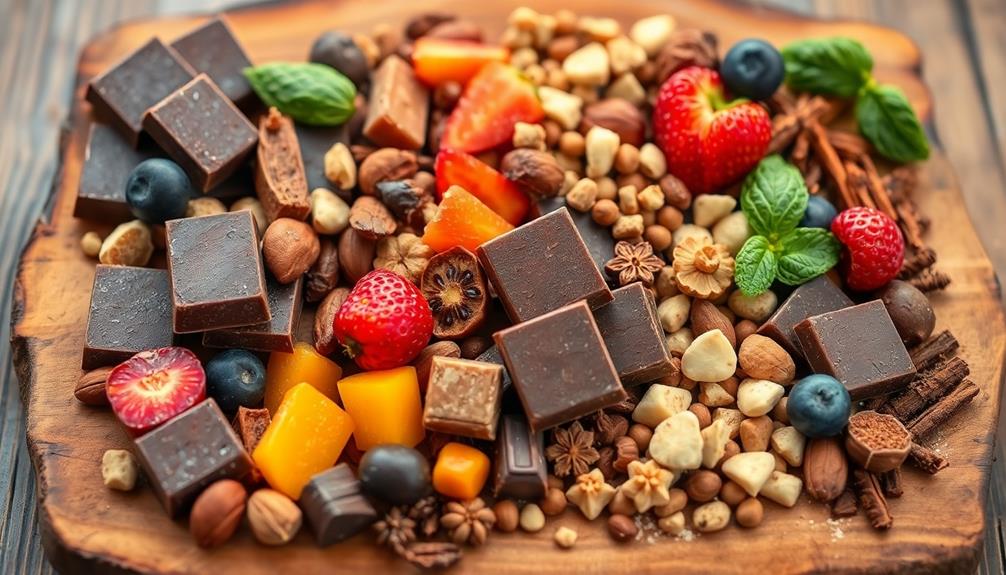
When diving into raw chocolate, understanding flavor profiles is essential for enhancing your tasting experience. The flavor profiles in chocolate are influenced by factors like cacao origin, processing methods, and cacao content percentage. You'll find that chocolate made from high-quality cacao can deliver a wide range of taste notes—from fruity and nutty to floral.
As you explore these flavors, pay attention to the aromatic complexity, which may include hints of spices, earthiness, and sweetness. Identifying these components is vital for creating effective pairing suggestions. For instance, if you taste a chocolate with fruity notes, you might want to pair it with fresh berries or citrus fruits.
Also, consider the mouthfeel of the raw chocolate. Whether it's creamy or gritty, the texture can greatly affect your flavor combinations. Complementary textures, like crunchy nuts or creamy cheeses, can elevate your tasting experience.
Principles of Food Pairing
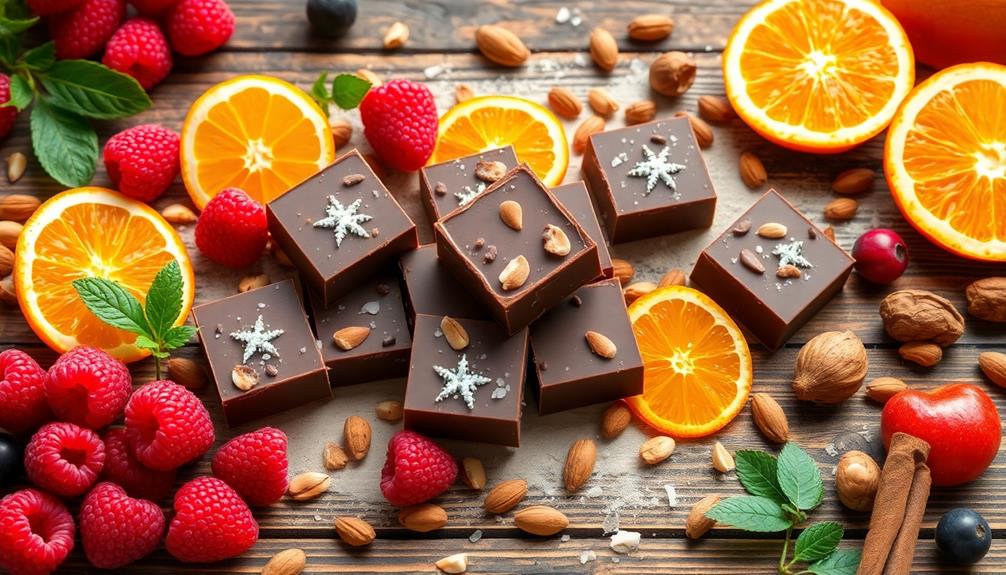
When you explore food pairing, focus on achieving flavor harmony and considering complementary textures.
Balancing smooth chocolate with crunchy nuts or creamy cheeses can elevate your tasting experience. Incorporating nutrient-dense ingredients like raw fruits and vegetables can also enhance your dishes.
Flavor Harmony Exploration
Flavor harmony is the key to a memorable culinary experience, especially when it comes to pairing raw chocolate with other foods. When you're exploring food pairings, aim to balance complementary flavors that enhance the rich notes of dark chocolate. Understanding how different tastes interact can elevate your chocolate experience; for example, sweet and salty pair beautifully, while bitter and sweet create an intriguing contrast.
Look for ingredients with similar aroma components to create a cohesive flavor profile. Think about spices and herbs that can add depth, like a hint of cinnamon or a touch of sea salt. These elements can harmonize well with the natural richness of raw chocolate, making each bite more enjoyable.
Don't shy away from experimentation! Unique combinations can lead to delightful surprises. You might find that pairing raw chocolate with certain fruits or nuts can reveal new flavor dimensions.
Complementary Textures Consideration
Often, the textures you choose to pair with raw chocolate can greatly enhance your tasting experience. Think about texture contrast; incorporating creamy elements can balance the richness of raw chocolate.
For example, pairing smooth chocolate with crunchy nuts or seeds adds an exciting dimension. The velvety mouthfeel of raw chocolate is beautifully complemented by textured foods like coarse sea salt or grainy cheeses, which create an interesting interplay in each bite.
You can also explore chewy textures, such as dried fruits or chewy candies, that harmonize with the rich, melting quality of raw chocolate. This combination can elevate the overall flavor profile, making each taste memorable.
Don't overlook temperature, either; warm, soft items like fresh bread or toasted pastries offer a comforting contrast to the cool, firm nature of raw chocolate.
Recommended Raw Chocolate Pairings
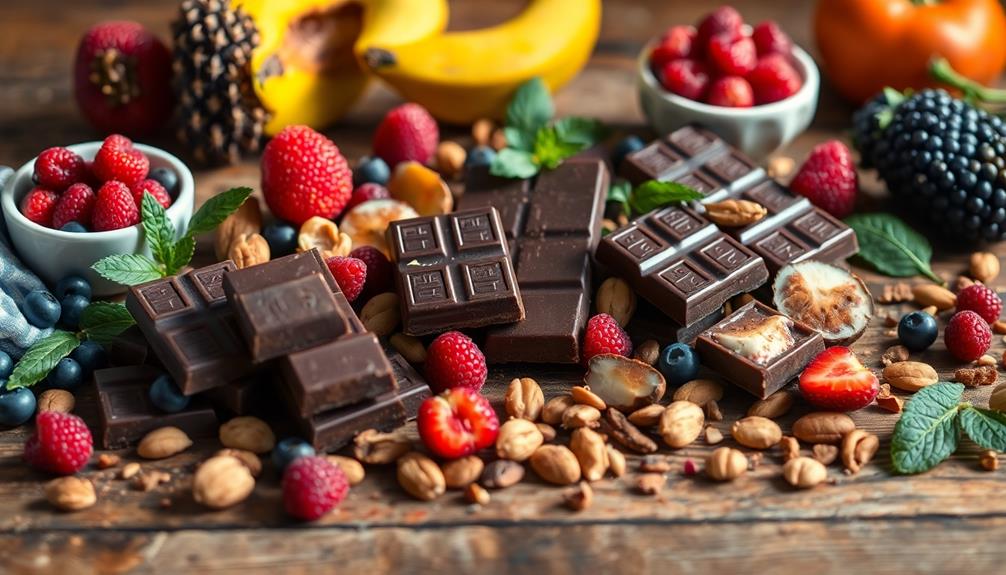
Raw chocolate offers a delightful culinary adventure, especially when paired with complementary ingredients. When it comes to fruits, think about incorporating raspberries or bananas. Their natural sweetness beautifully balances the rich, earthy flavors of the chocolate, creating a harmonious blend that's hard to resist.
Nuts like almonds and hazelnuts add a satisfying crunch, enhancing the texture of raw chocolate while contrasting its smoothness. You'll find that this combination not only elevates your experience but also makes every bite more enjoyable.
Don't overlook spices either; cinnamon and cardamom can transform your raw chocolate experience by adding warmth and complexity. These spices work wonders, harmonizing with chocolate's bitter notes and introducing an inviting depth of flavor.
For a rejuvenating twist, consider pairing raw chocolate with herbal teas like mint or chamomile. These teas offer a soothing contrast, amplifying the chocolate's aromatic qualities.
Enhancing Your Palate
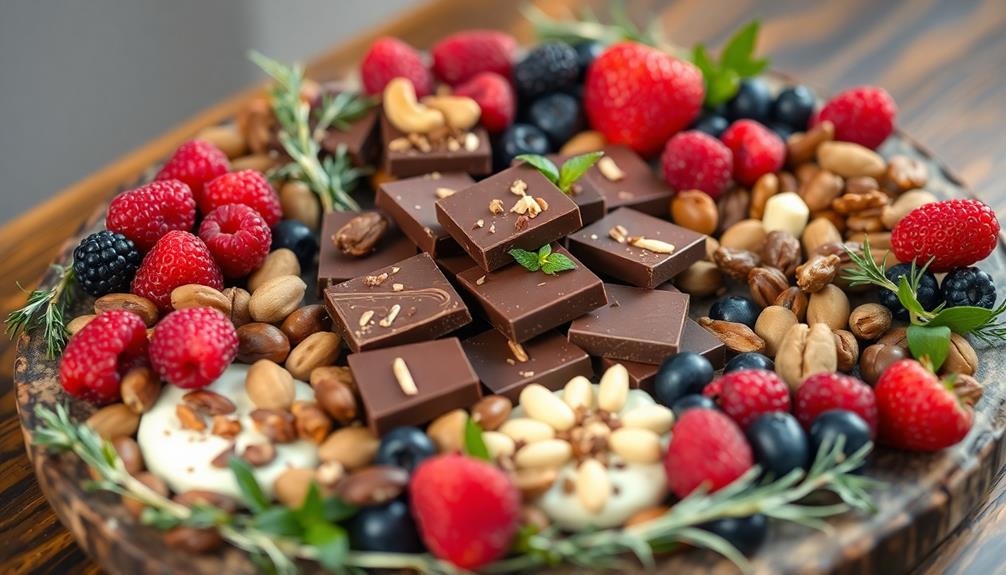
Exploring the world of raw chocolate doesn't just stop at pairings; it also involves honing your palate to fully appreciate its intricate flavors. Regular exposure to a variety of raw chocolates can greatly enhance your palate sensitivity, allowing you to recognize nuanced flavor notes with greater ease.
Engaging in mindful tasting practices is essential—focus on the aroma and mouthfeel to deepen your understanding of chocolate's complex profiles.
To refine your tasting experience, consider tasting chocolate in a systematic order: start with white, then milk, and finally dark chocolate. This method helps you discern flavors more clearly and appreciate the differences in sweetness, bitterness, and acidity.
Training your palate through repeated, focused tastings allows you to evaluate the interplay of these characteristics effectively.
Utilizing structured tasting techniques, like the "snap test" for texture and observing the chocolate's appearance, enhances your evaluative skills and helps identify high-quality raw chocolates.
Techniques for Tasting Chocolate
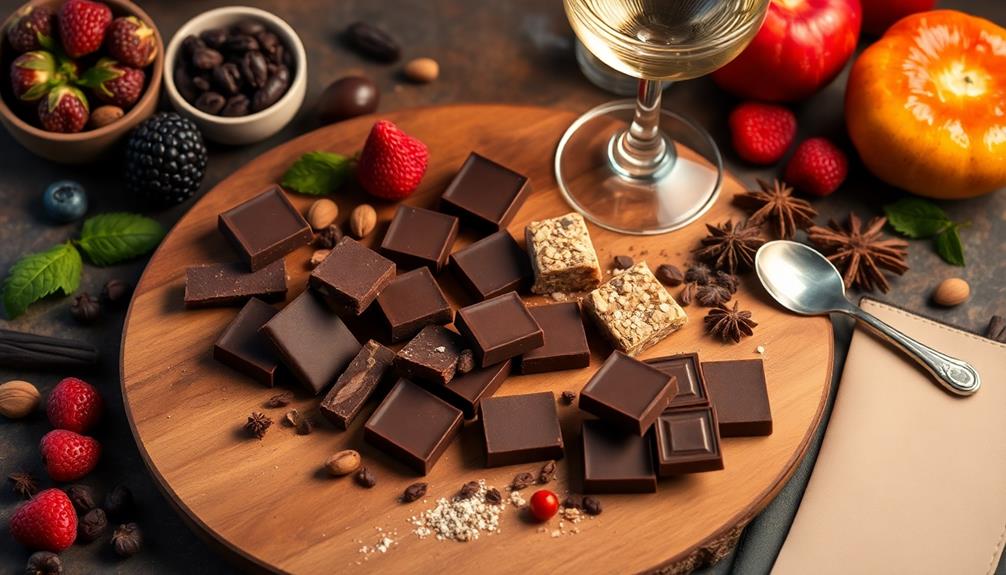
To truly appreciate raw chocolate, start by storing it properly in a cool, dry place.
When you're ready to taste, pay attention to the chocolate's appearance and aroma, as these factors set the stage for an amazing experience.
Chocolate Storage Guidelines
Keeping chocolate fresh and flavorful requires careful attention to its storage conditions. To maintain its quality, store chocolate in a cool, dry place away from direct sunlight, ideally between 60°F to 70°F (15°C to 21°C). High temperatures can affect the texture and flavor, so avoid refrigeration. Refrigerated chocolate often develops a white film known as "bloom," which compromises both its appearance and mouthfeel.
Use an airtight container for storage to prevent your chocolate from absorbing unwanted odors and moisture from the surrounding environment. Chocolate is highly sensitive to scents, so make certain your storage area is odor-free to protect its rich aroma and delicate flavor profiles.
When you're ready to indulge, let the chocolate come to room temperature before tasting. This step is vital, as it allows the full spectrum of aroma and flavor to unfold, enhancing your tasting experience.
Tasting Sequence Methodology
Beginning your chocolate tasting journey with a structured sequence enhances your experience and appreciation of its diverse flavors. Start with white chocolate, then move to milk chocolate, and finally indulge in dark chocolate. This progression allows you to savor the increasing intensity of flavors and aromas.
Here's a simple tasting sequence to follow:
- Observe: Check the appearance of the chocolate. It should be smooth and glossy, indicating quality.
- Snap Test: Break a piece of chocolate. A clean, crisp snap signals good quality chocolate.
- Melt & Roll: Place the chocolate on your tongue and let it melt in your mouth for a few seconds before chewing. This method maximizes the release of flavors and aromas. Engage all taste zones by rolling the chocolate around your mouth to enhance the overall flavor experience.
Evaluating Texture and Aroma
Evaluating the texture and aroma of chocolate is essential for a complete tasting experience. When you sample dark chocolates, start by observing the texture. A high-quality chocolate should feel firm but melt smoothly in your mouth, avoiding any waxy or grainy residue. This melt indicates the chocolate's quality and craftsmanship.
Next, focus on the aroma. Take a moment to inhale deeply and identify the different notes present—floral, fruity, nutty, or spicy. These aromatic nuances greatly enhance your tasting experience and provide insight into the chocolate's flavor profile.
To appreciate the full flavor, let the chocolate sit on your tongue for a few seconds before chewing. This allows the complex flavors to unfold gradually.
Roll the chocolate around in your mouth to engage all taste zones—sweet, salty, sour, and bitter.
Creative Pairing Ideas
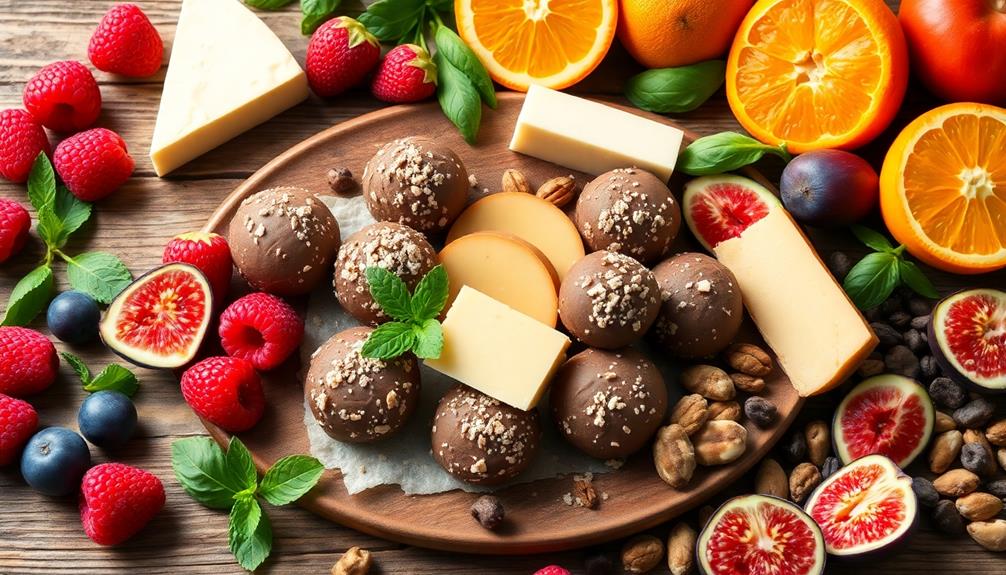
Exploring creative pairing ideas with raw chocolate can open up a world of flavors that enhance your culinary experience.
By experimenting with different ingredients, you'll discover delightful combinations that elevate the taste and texture of raw chocolate dishes. Here are three exciting ideas to get you started:
- Fresh Fruits: Pair raw chocolate with strawberries or bananas. The natural sweetness of these fruits enhances the chocolate's flavor while providing a revitalizing contrast that's hard to resist.
- Nuts: Mix in almonds or hazelnuts for a satisfying crunch. The nutty flavors complement the richness of raw chocolate and add an enjoyable texture to your treats.
- Spices: Introduce spices like cinnamon or chili to your raw chocolate creations. These can elevate your dish by adding warm, complex flavor profiles that bring depth and intrigue.
Don't forget to explore other options, like blending raw chocolate into smoothies with ingredients like spinach or avocado.
You can even incorporate herbal elements like mint or basil to brighten the overall flavor. Enjoy experimenting with these pairings!
Chocolate Pairing With Beverages
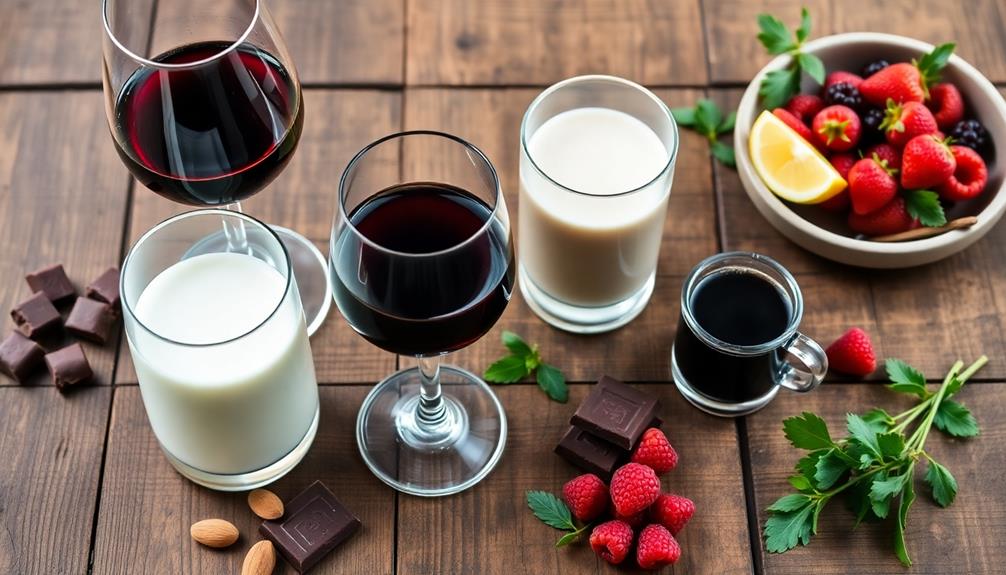
Pairing raw chocolate with the right beverages can elevate your tasting experience even further.
When you're enjoying dark chocolate, contemplate reaching for spirits like rum and bourbon. Their complementary sweetness and depth enhance the rich flavors and complexity of the chocolate.
For those who prefer wines, sweet dessert options like Port and Moscato are perfect for balancing the creaminess of milk and white chocolates.
If you're a craft beer enthusiast, stouts and porters are your best friends when it comes to dark chocolate. Their roasted notes and bitterness beautifully match the chocolate's intensity, creating a harmonious experience.
On the coffee front, dark roast coffees can elevate dark chocolates, while medium and light roasts work wonders with milk chocolates, enhancing their flavors.
For a revitalizing twist, sparkling wines, especially fruity rosés and proseccos, provide a delightful contrast when paired with chocolate pâtés and lighter chocolate desserts.
This combination adds a bubbly brightness that cuts through the chocolate's richness, making each bite even more enjoyable.
Featured Raw Chocolate Products
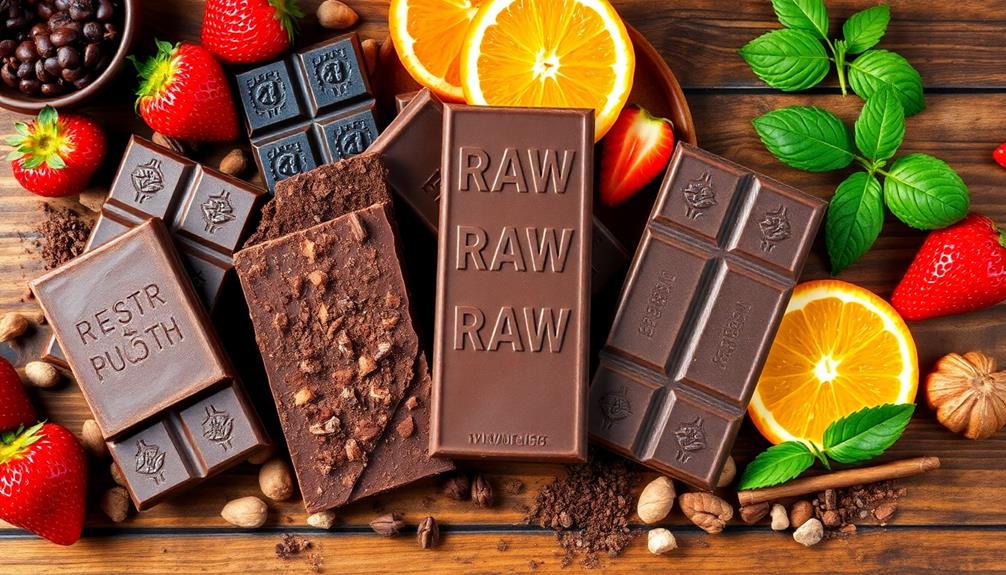
When it comes to raw chocolate, you'll find a delightful array of products that showcase the unique flavor profiles of cacao beans.
These fine quality offerings often feature minimally processed ingredients that preserve the high antioxidant content and health benefits of cacao. You'll love the diverse taste sensations, from fruity to nutty and earthy notes, that highlight the natural characteristics of the beans.
Here are three featured raw chocolate products to evaluate:
- Single Origin Chocolates: These bars come from a specific region, allowing you to experience the distinct flavors tied to the cacao's origin. Look for options with a high percentage of cacao for an intense taste.
- Raw Chocolate Bars with Superfoods: Many brands enhance their bars with superfoods like maca or goji berries, adding nutritional value while keeping sugar levels low.
- Ethically Sourced Snacks: Choose brands that emphasize fair trade practices, ensuring sustainable farming methods and supporting the communities cultivating cacao.
Explore these products for a delicious food pairing experience that aligns with your health-conscious lifestyle!
Unique Chocolate Recipes
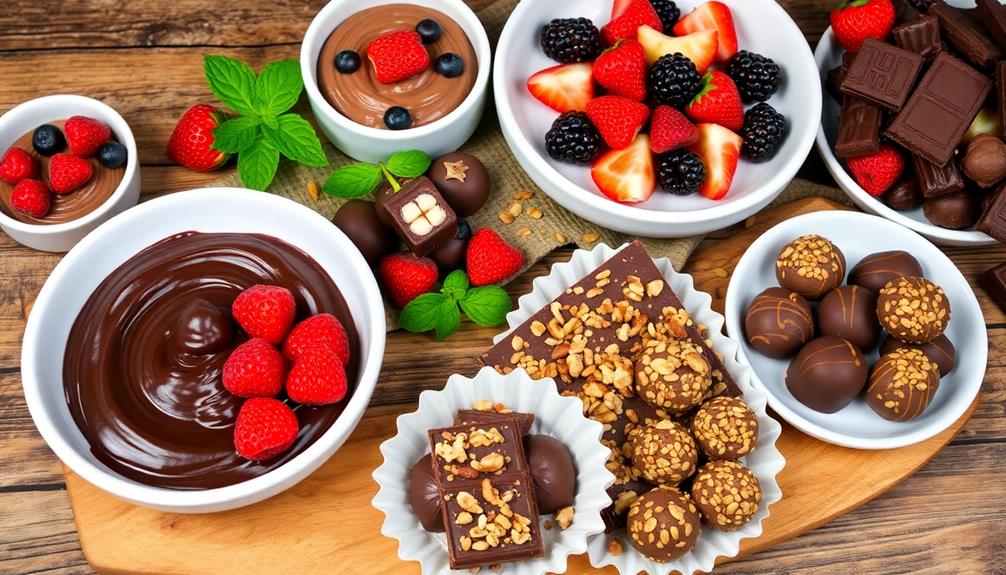
Creating unique chocolate recipes with raw chocolate opens up a world of delicious possibilities that cater to both your sweet cravings and health goals. From energy bites to savory dishes, there's something for everyone.
Here are some great pairing possibilities for your raw chocolate creations:
| Recipe Type | Key Ingredients | Flavor Profile |
|---|---|---|
| Energy Bites | Cacao powder, nuts, maple syrup | Nutty and sweet |
| Raw Chocolate Truffles | Cacao butter, dates, nuts | Rich and indulgent |
| Raw Chocolate Mousse | Avocados, cacao powder, agave syrup | Creamy and smooth |
Try mixing cacao powder with nuts and seeds for energy bites, or whip up raw chocolate truffles by blending cacao butter and dates, then rolling them in crushed nuts. For a revitalizing dessert, blend avocados with cacao powder for a mousse that feels indulgent but is healthy. You can even explore savory dishes like cacao-infused chili, which deepens flavor complexity. With these unique chocolate recipes, you'll satisfy your sweet tooth while enjoying the benefits of raw chocolate!
Frequently Asked Questions
What Food Pairs Well With Chocolate?
When you're pairing food with chocolate, think about bold aged cheeses, fresh fruits like raspberries, crunchy nuts, or even spicy elements. Salty snacks can also create a delightful contrast, enhancing your overall chocolate experience.
What Pairs With Cacao?
Imagine a modern-day alchemist; you'll find cacao pairs beautifully with fruits like bananas and berries. Nuts add texture, while spices and dairy create depth, and herbal infusions refresh, enhancing your chocolate experience like never before.
What Does Dark Chocolate Go Well With?
Dark chocolate goes well with full-bodied red wines, dried fruits, nuts, bold cheeses, and artisanal beers. Each pairing enhances its rich flavors, creating a delightful tasting experience you won't want to miss. Enjoy exploring!
When Paired With Chocolate?
When you pair chocolate with various foods, you're hitting two birds with one stone. Fruits add sweetness, nuts bring crunch, cheese offers tang, and spices amplify flavors, creating a delightful culinary adventure you won't forget.
Conclusion
Now that you're armed with the ultimate raw chocolate food pairing guide, your taste buds are about to set off on a thrilling adventure! Imagine transforming every snack into a luxurious experience, where even a simple piece of fruit feels like a five-star dessert! With the right pairings, you could become the chocolate sommelier of your friend group. So go ahead, release your inner gourmet, and create unforgettable flavor combinations that'll leave everyone begging for more!

